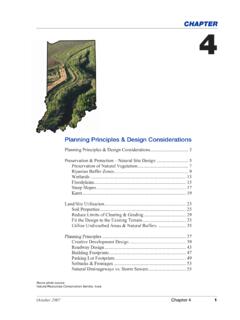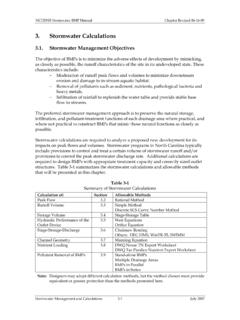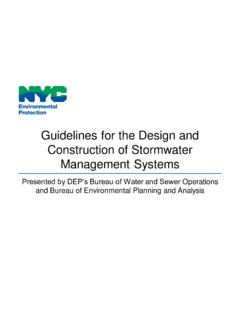Transcription of DESIGN OF STORM WATER DETENTION POND - Asian …
1 Yunnan Chuxiong Urban Environment Improvement Project (RRP PRC 45507) DESIGN OF STORM WATER DETENTION POND A. Background 1. Chuxiong Yi Autonomous Prefecture (Chuxiong prefecture) is located at about 160 kilometer (km) west of Kunming, the provincial capital of Yunnan province. The climate condition in Chuxiong prefecture is categorized as subtropical climate with short winter and summer, and long spring and autumns. Due to rapid and unbalanced urbanization, key cities and towns in Chuxiong prefecture (including the three project cities in Chuxiong Municipality, Lufeng County, and Wuding County) face serious urban development challenges including lack of infrastructure, poor road networks, and poor sanitary facilities. 2. Four rivers run through the urban areas of the three project cities and all have a flood history, with property damages and loss of Existing early flood warning systems are inadequate to reduce the flood damages in the events of severe storms.
2 The annual average precipitation in Chuxiong prefecture is over 900 millimeter, and rainfall is concentrated from July to September. Severe storms and heavy rainfall are common during this period and flooding in the urban areas occurs from time to time. Flooding is aggravated as a result of urban development with increased impermeable areas and inadequate STORM WATER drainage system and river embankments. The WATER quality of the project rivers is currently Class IV or worse. This situation will continue to block new initiatives to promote sustainable urban development unless pollution prevention and abatement measures are implemented. 3. The Yunnan Chuxiong Urban Environment Improvement Project aims to promote balanced and environmentally sustainable urbanization and socioeconomic development in the three project cities.
3 The project will support sustainable urban transportation, urban sanitation service facilities, and integrated urban flood control and river enhancement works including an advanced STORM WATER management. B. Principle of flood and STORM WATER management practice 1. Flood management principles 4. Generally, flood management is an approach to achieve a compromise a trade-off between the costs of social, economic, and environmental benefits of occupation and usage of flood prone areas against the risk, hazard, and consequences to these activities that cause flooding. Several common principles are applied to ensure safe and sustainable use of flood prone land under the project: (i) a proactive response to flood management in lieu of a reactive approach, (ii) management of risk and the flexibility to adapt to future uncertainties, (iii) an integrated mix of structural and non-structural measures, (iv) appropriate land use based on the level of hazard to minimize risk, (v) meeting community expectations with regard to adopted levels of protection and communication of risk to raise awareness, and (vi) enforced new or ongoing monitoring and evaluation systems.
4 5. Integrated risk management. Flood risk management measures are typically described as structural or non-structural measures: 1 Longchuan River in Chuxiong Municipality, East River and West River in Lufeng County, and Wulong River in Wuding County. 2 (i) Structural measures aim to reduce flood hazard by modifying the behavior of the flood, , reducing flood levels or velocities, or by preventing floodwaters from entering areas under threat. These are also often referred to as flood control measures. (ii) Non-structural measures aim to modify exposure to flood hazard or reduce vulnerability. This is done by either modifying the response of the population at threat, or by better planning and management of urban development in flood prone areas. 6. Structural and non-structural measures are complementary and one should not be considered to preclude the other.
5 The rapid rate of urbanization and threat of climate change may prompt a move away from an overreliance on hard-engineered defences towards more adaptable and incremental non-structural solutions. For the project, an integrated flood management strategy was adopted by combining both, with a strategy linked to urban planning and management policy and practices. Consideration was given to the level and characteristics of existing risk and likely future changes in risk in order to achieve an effective investment in STORM WATER management. 2. STORM WATER management principles 7. Traditionally, urban STORM WATER management has focused on rapidly collecting and conveying STORM WATER runoff to disposal in receiving waters. Based on this approach, urban development has changed watershed hydrology by increasing the amount of impervious surfaces , reducing vegetation, and introducing land uses that generate pollutants.
6 Increased impermeable area reduces natural infiltration and interception of rainfall resulting in increased runoff volumes and peak flow rates. This in turn leads to increased erosion and sedimentation, pollutant mobilisation and transport, and degraded aquatic ecosystems. 8. The effects of urbanization on STORM WATER runoff include increased total volumes of runoff and peak flow rates (Figure 1). In general, major changes in flow rates in urban catchment are the result of: (i) an increase in the volume of WATER available for runoff because of the increased impermeable cover provided by roads, streets, buildings, parking lots, and roofs, which reduce the amount of infiltration ; and (ii) changes in hydraulic efficiency associated with artificial channels, curbing, gutters, and STORM drainage collection systems, which increase the velocity of flow and the magnitude of flood peaks.
7 Figure 1: Effect of Urbanization on STORM WATER Runoff 3 9. In addition to the adverse impact on runoff quantity, STORM WATER runoff in urban areas is one of the primary sources of pollutants in urban streams and waterways. Contaminated STORM WATER washed off from roads, highways, parking lots, and lawns (often containing fertilizers and pesticides) is often classified as a type of nonpoint source pollution. Unlike other types of point sources, such as industrial discharge, wastewater plants and other operations, pollution in urban runoff is not attributed to one activity or even group of activities. Since it is not caused by an easily identified and regulated activity, urban runoff pollution sources are often treated as true nonpoint sources and require special STORM WATER management approach to rectify the problem.
8 10. Urban STORM WATER management in several developed countries has undergone transformation in recent years, from STORM WATER being considered a nuisance requiring rapid disposal to a more integrated urban WATER cycle management approach to achieve ecologically sustainable development. This requires a holistic approach to the management of STORM WATER runoff to integrate land use planning, urban landscape architecture, WATER resources management, and urban drainage infrastructure to address the multiple objectives of urban STORM WATER management. This approach therefore aims to protect urban waterway health and also to consider STORM WATER as a fit-for purpose WATER supply source. 11. Urban STORM WATER management systems typically include DETENTION or retention ponds to mitigate the negative impacts of urbanization on STORM WATER drainage .
9 DETENTION ponds empty after a STORM , whereas retention ponds retain WATER much longer above a permanent pool of WATER . Retention ponds are beneficial for providing STORM WATER abatement and the removal of pollutants from STORM The major functions and benefits of a retention pond include the following. (i) To retain urban runoff before releasing it into streams or other bodies of WATER . The urban runoff is released at flow rates and frequencies similar to those that existed under natural conditions (prior to land clearing and development). The flood volume held in a retention pond reduces the impact on downstream STORM WATER systems. (ii) To provide pollutant removal through settling and biological uptake (via aquatic vegetation). A typical retention pond can remove 30% 80% of certain pollutants from WATER before it enters other bodies of WATER or watersheds.
10 Common pollutants reduced are sediments, bacteria, greases, oils, metals, total suspended solids, phosphorous, nitrogen and trash. The retention pond is one of the most effective tool to provide channel protection and pollutant removal in urban streams. 12. Essentially, retention ponds provide both WATER quality and quantity control. Retention ponds are ideal partners for residential areas within proximity to any river, stream or watershed since retention ponds can enhance the environment and provide an aesthetically pleasing place for the residents. C. STORM WATER and flood management features in the project 13. Many cities in the People s Republic of China (PRC) lack an integrated, sustainable urban development concept. In the process of urban planning and development, while 2 In the US, many states such as California, Nevada, Idaho, North Carolina, and Florida realize the potential benefits of retention ponds.
















